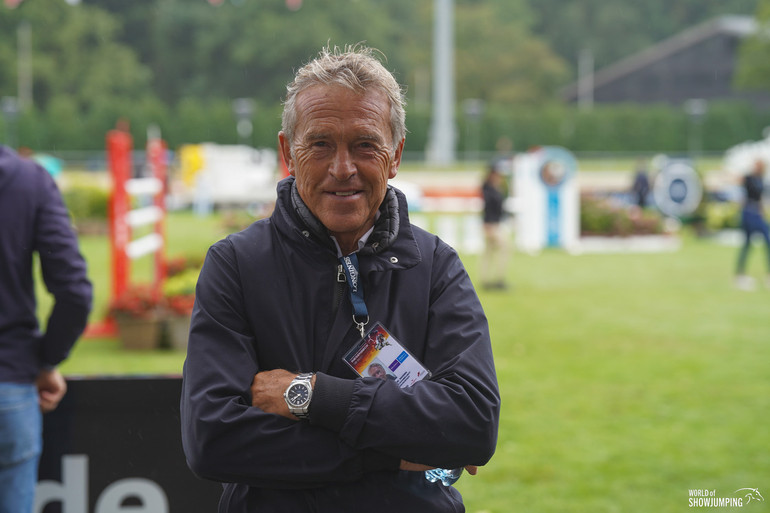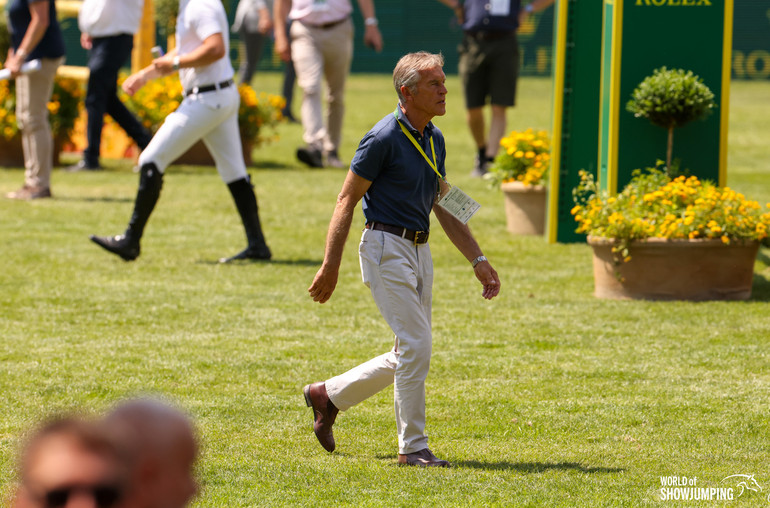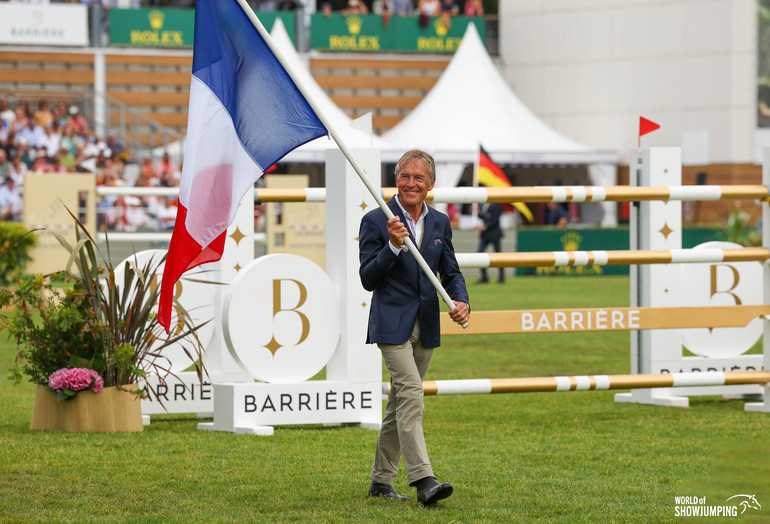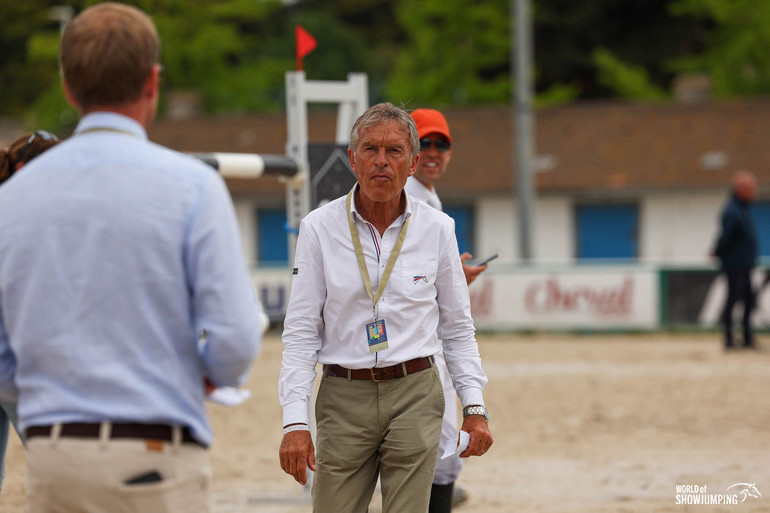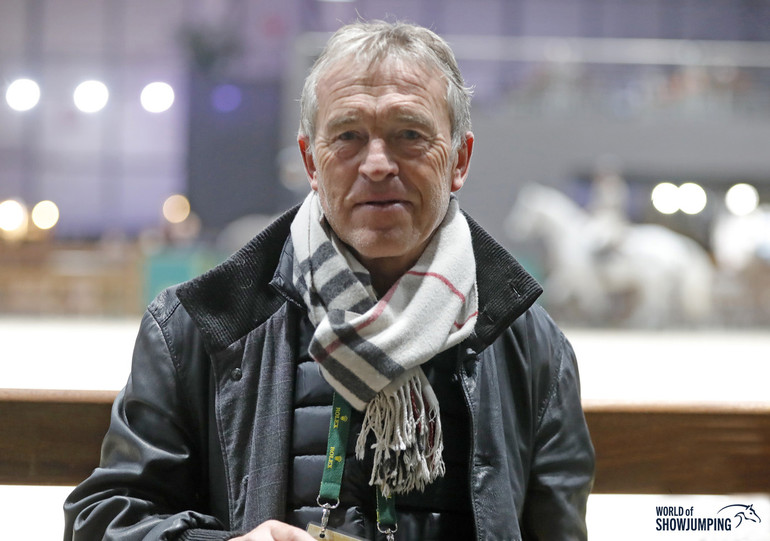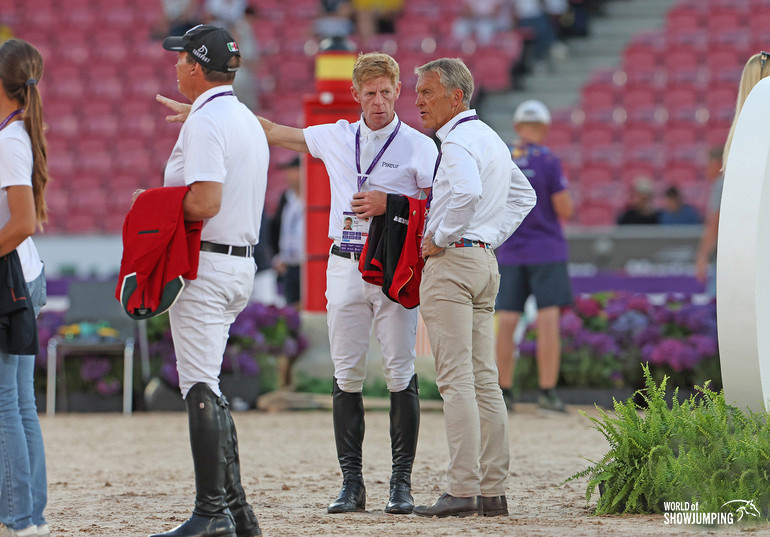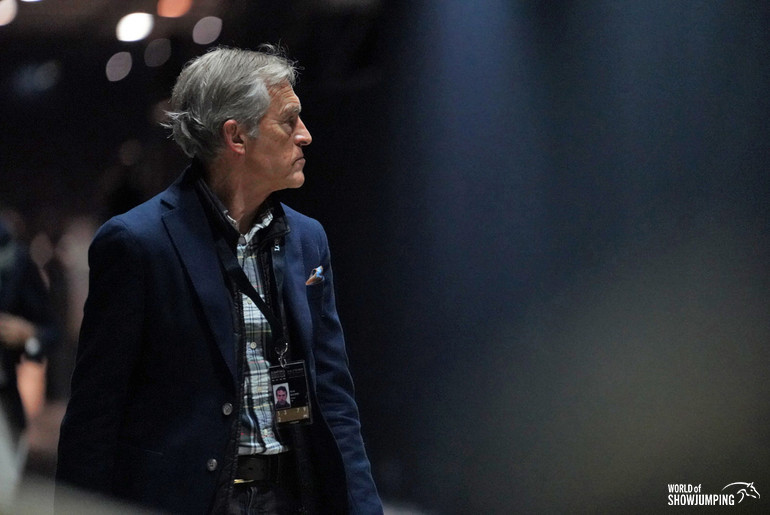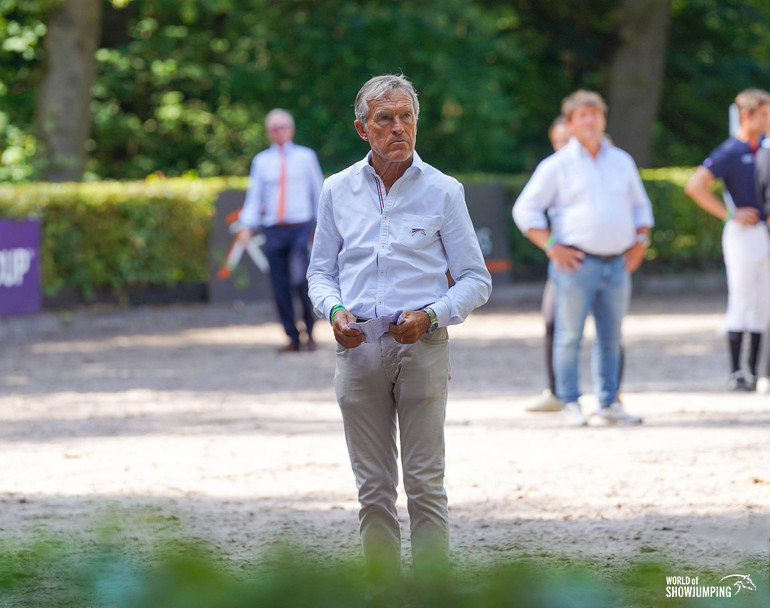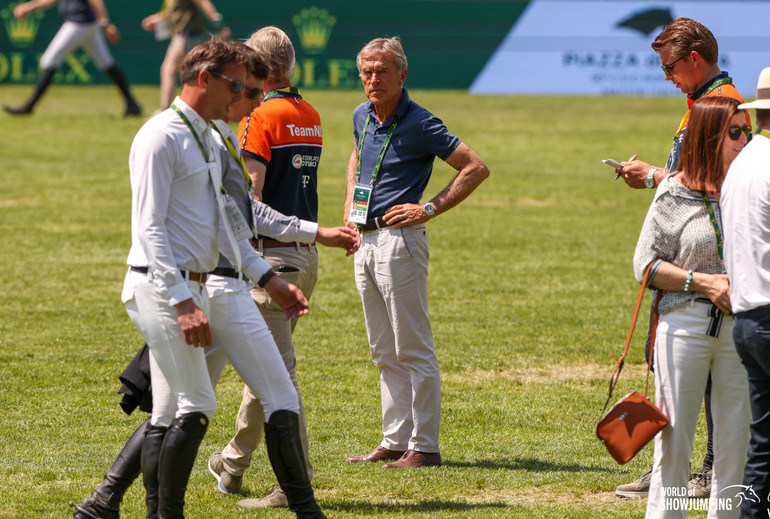Text © World of Showjumping
“Over the last decades, our society has changed and there is now a different attitude towards the relationship between horses and humans – which is utterly important to be aware of and understand for all those who are involved with horses; from breeders to grooms to riders,” Henk Nooren says to World of Showjumping.
And, when it comes to horses and the showjumping community, the 68-year-old knows what he is talking about. As a former Olympian, team world vice champion and European team champion, Nooren had huge success in the 70s and 80s before he went on to become one of the most sought-after coaches in the sport. Throughout his career, Nooren has trained the best of the best and has been successful as coach of the Dutch, French, Italian and Swedish jumping teams.
“I still find that the FEI and the national federations are not doing enough in this regard,” Nooren points out about the shift in society which has forced equestrians to become familiar with the term ‘social license to operate’.
“There should be a constant upgrade for all those who are responsible; from judges to stewards. Additionally, the officials should have more tools to work with and harsher rules to apply. As an example; if a rider crosses the finish line and pulls the horse left and right, that person should in my opinion immediately be called up to the jury box and be told that this is something we do not accept anymore. There are things we should not do, and there is not enough being done to react on those situations. In addition, we should also make sure to explain the non-horse public what our work with our equine friends is all about.”
There are things we should not do, and there is not enough being done to react on those situations
“I really hope – or, it is actually a must – that we for the next Olympics give our sport a better image than what was the case in Tokyo, where the issues in the modern pentathlon did not help,” Nooren points out. “However, in jumping we also had a few combinations that did not provide our sport with great publicity and I sincerely hope we can do better in Paris. However, in Tokyo, the sportive part was outstanding in my opinion, so I don’t think we can do a lot better than that – but from a horse welfare point of view, there is a lot to improve.”
Stepping in for the team
After more than five decades in the top sport, Nooren knows it inside-out – especially after being involved as a coach and Chef d’Equipe for some of the world’s strongest jumping nations throughout the last thirty years. “At the end of the 80s, the Dutch team – as well as the federation – were really in a low period,” Nooren tells about how he became involved with training. “For the 1984 Olympics in Los Angeles we could not even send a team; it was only Rob Ehrens that went there as an individual. Two years later, at the 1986 World Championships, the team finished outside the top ten and the best individual was somewhere below 30 on the result list. Within the federation, we decided we really had to do something, as we felt it was all going in the wrong direction. Therefore, it was decided that I would be in charge of the whole jumping department, which meant that I took over the training of the seniors as well as the role as Chef d’Equipe. Jos Lansink, Wout Jan van der Schans and Piet Raijmakers took up the regional training of all the younger riders – and this is basically how it all started, on January 1, 1987. Just by a small margin, we happened to qualify for the Olympics in Seoul, and then for two years, we worked hard – really hard. We met every second week and would train, train, and train, until we were more or less at an acceptable level – and then at the 1991 Europeans we were in the medals again, both with the team and individually.”
When I started to teach, I told myself that the most important thing is, for as long as possible, to stay curious and not think I have all the answers – and thank God I still feel like that
Before the 1992 Olympics in Barcelona, Henk moved on to train the Spanish team and has since then worked with the French, Italian and Swedish teams – more recently returning to France where he also was in charge from 2009 to 2012. “After working with Italy, I took a break – it was the first time I felt I needed to get away and re-think what I was doing and what motivated me,” Nooren tells. “Then – very slowly – I started to collaborate with the Swedes. It basically started with doing private clinics, and once the federation asked if I would be interested to work with the team, I said I would, but I did not want to be told by federation-staff what I could do and not. And for three years, they did not agree. In Sydney, I was helping three of the four Swedish riders – privately – because every time I asked their federation, they wanted to be in charge. It was only after Sydney that the Swedish federation agreed to give me free reins, and do what I thought was necessary for the team. Then it became fun and we had a few wonderful years together!”
Working towards Paris 2024
In 2009, Henk started to work with the French team for the first time. “My basic work is training and the other side is being a Chef d’equipe – the latter I don’t like that much,” Nooren explains. “Due to personal reasons, I left the French team at the end of 2012 and joined the Swedish team again in 2013 – which resulted in a medal at the Europeans in Herning and then Olympic qualification at the World Championship in Caen. However, after Caen, I had a feeling that the Swedish as a group were not doing enough for the future, so I left.”
Finally, I can perhaps say that I take time to fulfil both roles in a good way and I might even enjoy it all
“For a few years after, I did a lot of work with individual riders before going back to the French team in 2019. Now, I am their Chef d’Equipe and trainer, and my mentality towards both roles has changed. I spend more time with the team at the shows than I ever did in my life, and finally, I can perhaps say that I take time to fulfil both roles in a good way and I might even enjoy it all… So, you could say that I have gone through some development as well,” Nooren laughs. “With our eyes set on the Olympics in Paris and a medal there, I am focusing more on the riders that are doing the biggest Nations Cups, and, from my point of view, we have an excellent relationship. I visit them a lot at home, to discuss, to work with a few horses – and it is more about discussing, exchanging ideas and being a mirror to them, and them to me, than anything else.”
Two hard schools
Nooren is known for his beautiful and light riding style, a trademark he has passed on to many of his students. “For years, I was very stubborn,” Nooren reflects on his own riding career. “There were two riding styles back then. The European style dominated by the German way of riding, and then the American style which was totally the opposite – free and open – and I wanted to find something in between. In my attempts to find this golden middle, I went too far to the right, then too far to the left, then I came back to the middle… and at one point, ended up where the majority of the world is now, in between those two styles. It took me years, and I was hard-headed; good people were trying to tell me off and give advice, but stubborn as I was, I had to figure it out myself.”
Good people were trying to tell me off and give advice, but stubborn as I was, I had to figure it out myself
Though stubborn and determined to find his own way, there were two people who had a huge influence on Henk’s career: His father Kees and German legend Hans-Günther Winkler. “My father was an excellent riding teacher, even more towards dressage than jumping,” Nooren tells. “However, he was someone who would give you a little bit of information and then wait until you were begging for more. He was teaching in a very small riding school in Meppel, close to Zwolle in the Netherlands, and from that tiny riding school, three riders went on to compete for the Dutch team at the 1978 World Championships in Aachen; myself, Johan Heins and Dick Wieken. Already when we were quite young, my father would push us, saying he had no more knowledge to give and that we should extend our horizons – so I went to Hans-Günther Winkler.”
“I was twenty when I went to Winkler, and that was my second big school,” Nooren continues. “It was hard in the beginning, because Winkler was not someone who would explain – he would yell, and basically you had to figure out why yourself. When I went there, I was already a junior, young rider and senior champion, but for the first half a year, the only thing I thought about was giving up riding. ‘Bloody hell, I am never going to learn this’, was how I felt most days. However, when I got my foot into the door, with the little information Winkler gave me, I somehow kept going. That period was tough, more personally than anything else, but in the end, we became really good friends – he was one of the best friends I had. However, it was not an easy way to figure out this friendship and learning the way I wanted to ride.”
Observe, copy, think
“Today, I am in a privileged situation as I most of the time work with people who have a certain amount of talent,” Nooren says about his approach to training. “I am sure I would have a hard time starting with someone who has no feeling at all for riding.”
“What I do as a trainer – and what my father did as well – is trying to place myself in the position of the person I am teaching,” Nooren explains. “And from there, I explain step by step what this person should feel – it starts with that, that is the basic of teaching. Now-a-days, I think I have become more of a mirror, a partner to discuss with – especially with those that I work with on the higher level. With them, I exchange ideas about the how and the why. However, I get the same joy from teaching a beginner as I get from working together with my top guys; both give me huge pleasure in my job.”
Almost every weekend, I sit for hours and just observe how the best in our sport cope with different types of horses – and almost every week I come away with new ideas
“To this day, my most loyal student is Marcus Ehning,” Nooren says. “After all these years, we still exchange ideas all the time. Mostly we agree, sometimes we do not – and that is how it should be. On a personal level, it has also been a pleasure to work with someone like him; I would say he is my most important guy. It already started when he was at the end of his pony years: I used to come to the Ehning-family’s yard in Borken quite a bit to look at horses from Marcus’ father, and I got really annoyed with seeing Marcus ride. What he did back then, was riding too much with his body forward, throwing everything away on those last few strides, and that really annoyed me – ‘bloody hell’, I thought, watching this child. There were first some small remarks and slowly we started to work together. Whenever we are at the same shows, I am almost automatically drawn to watch him jump, and I for sure comment – but most often, only applaud.”
“What I constantly still do – because there is non-stop development in our sport – is that, almost every weekend, I sit for hours and just observe how the best in our sport cope with different types of horses and almost every week I come away with new ideas,” Nooren says. “We have to constantly adapt to the horses and the people we are working with. I am not at all stuck to one way; I try to take from all the best in the world when I think there is something they are doing great with a specific detail – I observe, copy, think.”
Rock the boat
In his careful observations of the sport, Nooren does not shy away from its political aspects. “How the FEI operates in its decision-making processes, worries me,” he says. “First of all, the voting system with one vote per country is problematic as there should be a difference in the weight of the vote depending on the size of the national federations – the American, French and German national federations’ votes should weigh more than that of a country which might not have a single horse-and-rider-combination competing actively. And, while the FEI is made up by our national federations, it is sometimes shocking to speak to those who are involved in these federations. Many of them are far removed from the sport, doing an honorary job, and they do not want to rock the boat.”
“Furthermore, over the years, the FEI Board has been given more and more power – and it has been done subtly. The FEI makes us believe that the stakeholders have influence and power, but in my opinion all we get are the left-overs – they do and choose as they want.”
How the FEI operates in its decision-making processes, worries me
“A recent example is the choice of format for the Longines League of Nations,” Nooren points out. “From one day to the next, FEI presented the League qualifiers as a concept with one round and a jump-off, a complete opposite from what had been presented to the stakeholders prior. The format the Jumping Committee eventually agreed on was a result of a negotiated compromise between the different committee members, after several stakeholders spoke against the FEI’s plans to change the format to one round.”
“I hope that we are not missing out on all the important and traditional venues,” Nooren says about how the Longines League of Nations will consist of only five qualifiers world-wide. “Luckily, we still have the stand-alone Nations Cups like Aachen, La Baule, Rome, and Spruce Meadows, which are all excellent. It is a pity it’s not possible to combine these with the League; it would have created a series of the absolute best venues in the world. However, I think they can all live beside one another. And, if the new project really comes off the ground as it is written on paper, we might have a good series.”
A closed circuit
“What should worry us all, however, is the development of our sport worldwide,” Nooren continues. “With the new League, we will have the ten best teams in the world competing against each other, making each other better – but what about the rest? This worries me; it will be a closed circuit, but then there are all the other countries that should be in contact with the high-level sport too. If we want to keep growing as a global sport, developing equestrian nations have to stay in touch with the very top – one way or the other – and I think this should be our biggest concern for the next couple of years.”
With the new League, we will have the ten best teams in the world competing against each other, making each other better – but what about the rest?
To ensure global development of the sport, Nooren believes that it would be constructive to look at the structure of the European football leagues. “We have the five-star Nations Cups, a few four-stars, the three-star Nations Cups and the EEF series,” Henk details. “To keep developing and ensure that all countries can stay in touch with the top sport, I think that every country that wants to participate in a three-star Nations Cup should be obliged to organize one. Don’t forget, we have lost out on so many nations! We should look to football, that has the Champions League, Euro League and Conference League and try to do something similar. As an example, we could create an Euro League from the remaining five-and four-star venues that are not part of the Longines League of Nations, and these events should be open to nations which are not represented in the new series. And then there could be a Conference League with all the rest of the three-star Nations Cups worldwide. If we could develop on all these levels at the same time, I think everyone would have a chance to stay in touch with the sport.”
Stay curious
“To me, most riders are riding better than ever, there are so many who ride correctly, but are we losing out on horsemanship? Perhaps we are,” Nooren reflects on the status quo of the sport. “We have riders buying ready horses instead of growing up with them as an animal – who do not know about grooming, vetting, shoeing; there is a certain gap in the knowledge there. However, through all these years, seeing the most expensive horses being sold, the naturally gifted, talented riders are still on top and that for me is a relief. There are exceptions to that rule as well, but in general it is the ones that are talented and want to work that come out on top. It proves that in our sport, success cannot be bought. For the future, the horse-human relationship is vitally important and seeing couples like Henrik and King Edward is something to really admire and enjoy.”
This is my life, my sport, and the development of the sportive side keeps me running and enthusiastic
“This is my life, my sport, and the development of the sportive side keeps me running and enthusiastic – the other parts we just have to live with and do what we can,” Nooren says. “You have to live with it or step out – and I am not ready to step out yet, I happily do whatever I can. The sport is continuously developing, and, for me, that is the nicest and most interesting part; seeing how perhaps Marcus Ehning started to influence a certain way of riding – the way showjumping should be – and now we have riders like McLain, Henrik, Steve and Julien, all doing it their own way. Watching these horse-and-rider-combinations, seeing them work and admiring what they are capable of doing together – that is what I enjoy the most. This is what keeps it all so interesting and what keeps me so motivated; the constant development of the sport.”
“When I started to teach, I told myself that the most important thing is, for as long as possible, to stay curious and not think I have all the answers – and thank God I still feel like that,” Nooren concludes.
26.7.2023 No reproduction of any of the content in this article will be accepted without a written permission, all rights reserved © World of Showjumping.com. If copyright violations occur, a penalty fee will apply.



